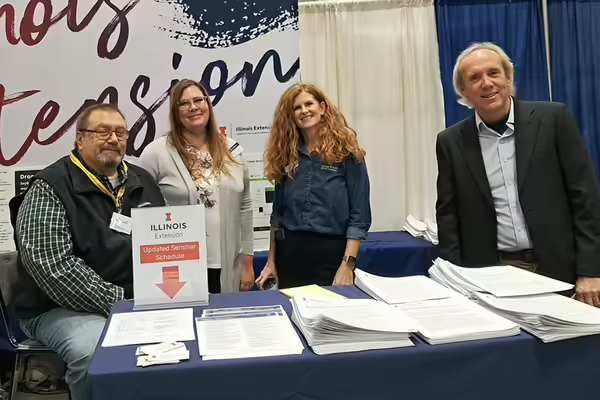
PEORIA, Ill. — Meet with agriculture specialists from University of Illinois Extension and learn about the latest research impacting farms today while attending the Greater Peoria Farm Show, Dec. 2-4.
Show attendees can visit the Illinois Extension booth during show hours on Tuesday and Wednesday from 9 a.m. to 4 p.m. and Thursday from 9 a.m. to 3 p.m. to discuss questions and find resources on farm leasing, grain marketing, farm estate planning, fertilizer management, fertility programs, nutrient loss, cover crops, and reduced tillage. The booth will also feature information about the Master Gardener and Master Naturalist programs and Conservation@Home.
“Extension offers farmers and producers a unique opportunity in that we offer non-biased, research-based information as we are not selling anything,” says Tara Heath, Illinois Extension commercial agriculture educator. “We’re here to help farmers make informed decisions about their unique operations.”
Throughout each day, Extension educators and University of Illinois Urbana-Champaign faculty will be sharing informative presentations. Topics include fertilizer management, plant abnormalities, farm succession planning, insect management, and more. See the full schedule of presentations at go.illinois.edu/GreaterPeoriaFarmShow.
New this year, Certified Crop Advisers can earn continuing education units by attending the presentations. “Partnering with the Illinois Certified Crop Adviser program to offer CEUs demonstrates a commitment to professional excellence and science-based learning,” says Heath. “Farmers benefit from working with Certified Crop Advisers because CCAs are required to pass rigorous knowledge exams, commit to ongoing continuing education, and uphold a professional code of ethics—ensuring they provide reliable, science-based guidance tailored to today’s agricultural challenges.”
Supporting the agricultural community is a key priority area for Illinois Extension, and producers in west-central Illinois are benefiting from the expertise of a team of commercial agriculture educators who share information and services with their local communities.
“Extension has a long history of supporting agriculture at the local level,” says Janice McCoy, Illinois Extension associate director for Region 2, covering the west-central portion of the state. “Our commercial agriculture program is growing, and our participation in the Greater Peoria Farm Show is an exciting opportunity to showcase the resources and research from University of Illinois and Illinois Extension.”
McCoy highlights agriculture as a major economic driver in the region that contributes significantly to the culture and viability of our state. “Our local farmers help to feed our neighbors and the world," says McCoy.
Along with the educational presentations, Extension educators and specialists will be available for media interviews at their booth during show hours.
The Greater Peoria Farm Show will be held at the Peoria Civic Center located at 201 SW Jefferson Avenue. There is no cost to attend, and parking in the Civic Center lots is free.
For more on Illinois Extension’s impact on agriculture and to find a local office, visit extension.illinois.edu. If you need a reasonable accommodation to participate, contact Tara Heath, tsheath@illinois.edu or 309-347-6614. Early requests are strongly encouraged to allow sufficient time to meet access needs.
SOURCE: Tara Heath, commercial agriculture educator, Illinois Extension
University of Illinois Extension develops educational programs, extends knowledge, and builds partnerships to support people, communities, and their environments as part of the state's land-grant institution. Extension serves as the leading public outreach effort for University of Illinois Urbana-Champaign and the College of Agricultural, Consumer and Environmental Sciences in all 102 Illinois counties through a network of 27 multi-county units and over 700 staff statewide. Extension’s mission is responsive to eight strategic priorities — community, economy, environment, food and agriculture, health, partnerships, technology and discovery, and workforce excellence — that are served through six program areas — 4-H youth development, agriculture and agribusiness, community and economic development, family and consumer science, integrated health disparities, and natural resources, environment, and energy.